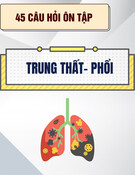
31
Journal of Medicine and Pharmacy, Volume 10, No.7/2020
High prevalence of physical inactivity among adolescents
in Thua Thien Hue province in 2017
Ha Van Anh Bao1, Tran Thi Hang2,
Hoang Thi Viet Ha2, Ton Nu Minh Duc2, Nguyen Thi Anh Phuong2
(1) Danang University of Medical Techonology and Pharmacy, Vietnam
(2) Hue University of Medicine and Pharmacy, Hue University, Vietnam
Abstract
Background: Physical activity (PA) plays a vital role in both physical and mental development of
adolescents. This study aims to determine adolescent physical activity status and several related factors
and to preliminarily evaluate its effect on the development of adolescent height and weight. Materials
and Methods: This analytical cross-sectional study involved 932 students, chosen by the multi-stage
sampling method. The data were collected by a structured questionnaire referenced from GSHS and YRBS
questionnaires and the measurement of height and weight. Results: Physical inactivity among adolescents
accounted for 71.1% (95% CI: 68.1 - 74.0), in which female adolescents is higher than male adolescents
(77.4% vs 60.6%). For every one-day increase of meeting the PA recommendation, there is a growth in
adolescent height and weight corresponding to 0.41 (cm) (95% CI: 0.14-0.68) and 0.37 (kg) (95% CI: 0.14-
0.61), respectively. Gender and received the parent concerns were two factors which are most effective to
physical inactivity in adolescents. Conclusions: Lack of PA still being an alarming concern, especially among
adolescent girls. Physical inactivity could affect the development of height and weight during adolescence.
Taking more robust measures must be needed to improve PA for adolescents.
Keywords: Physical inactivity, adolescent, Thua Thien Hue province
Corresponding author: Ha Van Anh Bao, email: drhabao.med@gmail.com
Received: 28/10/2020, Accepted: 20/12/2020
DOI: 10.34071/jmp.2020.7.5
1. INTRODUCTION
Physical activity (PA) helps to prevent diseases
in healthy people and quickening recovery for sick
people. Frequently doing physical activities can
bring various health benefits such as strengthen
and developing musculoskeletal system; reduce
the risk of cardiovascular diseases (hypertension,
stroke, etc.), diabetes, cancer, depression, et cetera
[14, 15]. Physical activity is critically important for
the natural development of physical and mental
ability in adolescents, and its fluctuation in the
adolescent development process can result in their
psychophysiological and physical changes in the
future [17].
It estimated that as many as 3.2 million deaths
worldwide are attributable to physical inactivity
[10]. According to the systematic review of 2384
articles, the proportion of adolescents lacking PA
is 79.7% worldwide [4]. In the USA, the proportion
of adolescents who do not meet the standards
announced by the World Health Organization and the
US Department of Health is approximately 87.4% [8].
In Vietnam, children aged under 18 years old account
for 30% of the population following UNICEF statistics
in 2012, 80.3% of which lack physical activity [2]. These
numbers are alarming and also a major risk factor
leading to an increasing rate of non-communicable
diseases, physical retardation and even cancer in
Vietnam as well as around the world [15].
Therefore, to have deep interventions to the
adolescent PA habits, initial research is needed to
describe the children PA habits as well as the factors
related to PA. In Vietnam, there were several studies
of adolescent PA regionally and nationally. However,
these studies are no longer appropriate due to their
old rates in PA pattern and because a few involved
factors mentioned. Meanwhile, in Thua Thien Hue
Province, there is no specific research related to
PA in adolescents. For all of the above reasons, we
implemented the study with the aim to:
1. To determine the physical activity status and
several related factors among adolescents in Thua
Thien Hue Province in 2017.
2. To preliminarily evaluate the effects of physical
inactivity on the adolescent development of height
and weight.
2. MATERIALS AND METHODS
This analytical cross-sectional study was
conducted among adolescents who aged from 10 to
19 years old in Thua Thien Hue Province from June
2017 to April 2018.






























